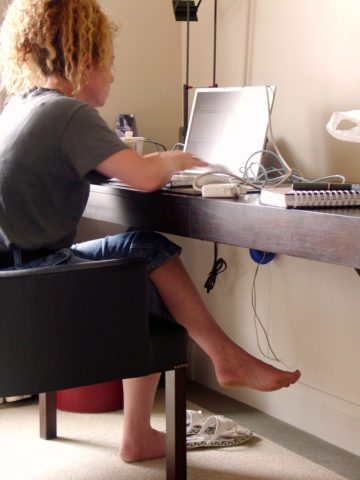 If you think you might be experiencing signs of Carpal Tunnel (or RSI: Repetitive Strain Injury), read Part One of this 2-part series to help you assess the problem first.
If you think you might be experiencing signs of Carpal Tunnel (or RSI: Repetitive Strain Injury), read Part One of this 2-part series to help you assess the problem first.
Following are a variety of things that you can do to alleviate the pain associated with neck pain and Carpal Tunnel Syndrome by making your work space more ergonomic.
Use these tips to make adjustments in your current work space or to help you when making purchasing decisions on a new items for your home or work office.
Personal and professional treatments and recommendations are also listed.
What Is Ergonomic?
The label “ergonomically designed” is a subjective one.
In fact, there is no regulation of the term ergonomic — meaning that virtually anyone can claim that their product is ergonomic.
You should know that some ergonomic products can even make things worse.
Your best bet is to use the guidelines below to create the most ergonomic space while working at the computer.
Simple Things You Can Do Yourself
Many computer users are in chronic pain that is NOT alleviated by ergonomic changes or physical therapy. The reason is this: You cannot solve a medical problem simply with ergonomics.
The time to invest in an adjustable ergonomic workstation is before you become injured. Act before it’s too late, so you will remain pain-free while working at the computer.
First, learn how to determine which factors in your current workstation setup are giving you the most problem, based on the areas of your body where you are having the most discomfort.
Second, try these simple things to make your workstation more ergonomic:
- Tilting your head too far back or too far forward for extended periods will put too much strain on the neck. Your head weighs 10 pounds. For every inch it falls forward, in front of your shoulders, you’re adding 10 more pounds of pressure to your neck.
- Make sure that you are using both your keyboard and your mouse in the most neutral position. Ideally, your arms and shoulders should be relaxed while typing, and your mouse arm should remain close to your body, rather than at a distance where you have to reach to access it. This way, your upper arm remains relaxed, your elbows are at your side, and your posture remains as neutral as possible.
- When seated at the computer, make sure that your feet are supported and the area behind your knees is not compressed. You can also use a footrest (or a pile of books or a box) to alleviate the pressure behind the knees.
- To keep your back in the best position while seated at the computer, place a pillow or backrest between you and the chair back. Or, use a rolled up towel.
- Make sure that you change you posture while seated at the computer frequently. There should not be a “typical” position that one could always find you in at the computer. You don’t want to remain in any one posture for too long. While waiting for pages to load, make a conscious effort to change your body posture, relax your arms at the side of your body, or better yet, stand up and stretch.
- Follow the 20/20 rule: Every 20 minutes, take a 20 second break! Follow this to a tee, and you’ll thank yourself at the end of the day.
Here are some quick tricks my chiropractor taught me to relieve neck pain. And some neck stretches that I do at the computer regularly.
This video shows how to correctly align your body while sitting:
- Make sure your table or desk is a comfortable height for the tasks you will be performing: writing (28-30 inches), mousing (27-29 inches), or typing (26-28 inches).
- The ideal computer desk has a pullout, height-adjustable keyboard tray and mouse platform.
- If your chair has armrests, make sure your desk can accommodate them when you pull up to the desk.
- A center drawer may seem practical, but could get in the way by reducing your legroom and forcing you to sit farther from the desk than you’d like.
- Your chair should have both height and back adjustment features.
- Ideally you want a chair that reclines slightly. Sitting erect or leaning forward increases the strain on the lower back, whereas reclined postures relax the body. Plus, the upper and lower back are well supported by the chair, and back muscle activity and lumbar disc pressure are low.
- Ergonomic chairs support your lower back and help to reduce neck strain, among other things.
- You shouldn’t have to raise your shoulders to get your hands to reach the keyboard — try raising your chair instead.
- The keyboard should be placed just above the level of your lap. This lets your arms tilt downward slightly while using the keyboard, leaving your elbows at a comfortable “open” angle.
- While typing, your keyboard should lay flat or with a slightly downward slope – don’t prop up the back of your keyboard or extend the ‘feet’.
- Most ergonomic keyboards on the market today are split keyboards — where the alphanumeric keys are split and at a slight downward slope.
- Place your keyboard so that the space bar is roughly the same height as your elbows.
- Most people center themselves with the entire keyboard. However, keyboards aren’t symmetrical — the letter keys are on the left and the numeric keypad on the right — and such a position would put the keyboard too far to the left. You should align your keyboard so the “B” key is lined up with your belly button.
- To minimize trauma to your hand and arms, use a light touch when typing.
- Don’t hover over the keyboard (with your fingers in the typing position) if you’re not actually typing. Any time you’re not typing, your fingers should be relaxed at your sides — giving them time to “recharge” with a fresh supply of blood-flow, rather than become fixated in one position.
- Your mouse should be at approximately the same level as your keyboard, and positioned close to your keyboard so that you don’t have to reach.
- If your wrist extends upward when your hand is over the mouse, then it’s not an ergonomic mouse. A flatter and broader mouse can reduce side-to-side wrist deviation which often results in the most damage.
- Don’t hold the mouse (or rest your hand on it) when you don’t have to. Any time you’re not browsing with the mouse, your fingers should be relaxed at your sides — “recharging” with a fresh supply of blood-flow, rather than becoming fixated in one position.
- Consider switching to a trackball instead of a mouse. Trackballs are stationary devices that use a small, rolling ball to move your cursor. They are operated by your thumb or fingers instead of your arm, thereby reducing the distance your shoulder must travel. Since they’re stationary, trackballs also require less desk space than a traditional mouse. Many trackballs come with multiple buttons that can be assigned keystrokes to help reduce keyboard use as well.
- Move your monitor or laptop screen. To reduce eyestrain and set up your computer workstation most efficiently and ergonomically, you should place your monitor at least 20 inches away. If you have difficulty seeing it at this distance, then enlarge the image on the screen.
- Truth is, staring at a monitor for prolonged periods of time can lead to headaches, eyestrain, blurred vision, dry and irritated eyes, slow refocusing, neck and/or backache, sensitivity to light, double vision and even color distortion.
- The one means of alleviating pain and discomfort that hasn’t quite caught on commercially yet is the ergonomic armrest. An armrest allows you to rest the area of your forearm that lies halfway between your wrist and elbow, without any pressure on any part of the arm. Look for armrests with height and width adjustment features. You could also use a broad, flat wrist rest that is typically used for wrist support in front of your keyboard as a forearm support instead. Rest your entire arm (elbow to wrist) on this or a small pillow.
- Arm and wrist rests should be approximately the same thickness as the bottom of your keyboard. Not thicker! And they should be used to rest the heel of your PALM, not the wrist itself.
- Wrist rests should not be used as actual resting places for your wrists while typing. Instead they should be used as a place to rest your wrists in between periods of typing. This is because wrist rests (especially the very soft, cushioned kind) actually contour to the wrists, encouraging too many bad wrist twisting movements.
- If your chair has armrests, they should comfortably support your elbows during rest breaks, rather than while you are typing.
- Learn the keyboard shortcuts for the most-used tasks that you typically perform with the mouse. If you can perform an action with the mouse, then you can perform that same task with a combination of keyboard strokes instead. Many computer shortcuts are standardized, which means a particular shortcut in one program will likely do the same thing in other programs as well. Simply determine your MOST routine mouse clicks, then make a list of their keyboard shortcuts. Soon, performing keyboard shortcuts will become just as quick and easy as your mouse clicks once were.
- Consider taking a well-deserved break from those computer/video games which often involve long sessions of very tense keyboard or mouse usage!
- Whenever time permits, enjoy a little keyboard yoga while you’re seated at your computer.
Professional Help For Alleviating Pain
It is important to treat carpal tunnel syndrome early, because it can be reversed. However, if treatment is delayed, then the symptoms will likely worsen, and surgery may become necessary to reverse the damage.
One popular form of treatment for ongoing sufferers of carpal tunnel syndrome is the injection of steroid medication into the problem areas of the wrist and hands.
Wrist splints and specially-made support gloves are abundantly available in stores these days, however, you should not wear them without the guidance of a doctor first. Most people don’t realize that such wrist splints should only be worn at night; never while doing daily tasks. They should also be worn loosely, so as to not restrict blood flow. A treatment plan involving such items must come from a doctor, otherwise, more damage could be done in the long run.
Summary
Correct use of the keyboard and mouse are critical to preventing carpal tunnel syndrome for individuals who work long hours at the computer.
Make sure you follow the above guidelines to achieve the most ergonomic position at the computer.
Let’s face it, this is serious stuff! Ergonomics is now being taught at universities across the globe, as well as being offered as part of corporate training.




